If you missed it, check out my review of Kathy’s wonderful language arts materials and Book of Centuries.
This is a guest post by Kathy Weitz.
The Schole Sisters have done a fabulous job of telling y’all what a commonplace book is and why you should do it. I have also written about my own personal journey with commonplacing.
Commonplace books are a fixture in our homeschool and in our local classical liberal arts co-op, Providence Prep, where I teach literature and English Studies. In fact, the copybooks and commonplace books are at the heart of the language arts curriculum which we are developing at Cottage Press.
If keeping a commonplace book is new to you, I hope the some of the principles and practical ideas culled from my own homeschool and co-op experience will help you get a good start. I have to be honest — my practice often falls short of my principles, and yet I can say that even our imperfect implementation of commonplace book keeping has been key in aiming my students toward a life well-read.
Our Commonplace Books
My students keep commonplace books from junior high on, averaging three or four commonplace entries per week. These are often specific assignments based on current reading in literature and language arts classes at Providence Prep. Since we meet on Fridays, my own kids tend to group their commonplace entries on one or two days late in the week. They generally do their reading earlier in the week, marking passages that they might like use for their commonplace book later.
Yes, we do write in our books! I know some of you will be aghast at such a thing, nevertheless, it is true. I adore reading a book for the second or third time and seeing my earlier comments and questions, and adding new ones. It becomes a record of my personal growth as a reader, as a thinker, and as a child of God. It is one way that I wade into the Great Conversation.
Of course, this also means that students must own the books they study, so we make provision for that in our curriculum budgeting. Wherever possible, I favor buying books over curriculum. I really mean that, even though I publish curricula! I am aware that this may not be an option for every family, but there are also areas where we are very frugal, including Christmas, birthdays, and extracurricular activities. Instead, we invest in building lifetime libraries for our kids.
Making Commonplace Entries
Every week I ask my literature students to copy at least one favorite passage from their assigned reading. We share as many of these as possible in class. They range from the profound and inspirational to the hilarious and ironic. Occasionally, they try to see if they can totally gross the teacher out (not too hard when we are reading ancient epic poetry – not sure which is worse, blood and gore, or snakes . . .).
My English students, who are currently piloting several levels of Poetics & Progym, the upcoming language arts courses for upper school students from Cottage Press, are given several additional specific assignments each week. Most often, they are to find the particular figure of speech we are currently studying. Or they may need to find a poem with a particular rhyme scheme or meter or stanza form.
Almost every week l also ask them to record an example of ANY figure we have learned thus far. For this, they may widen the field and look in any books they are reading, sermons they have heard, or songs they have sung. I delight to sit in class and hear these teens eager to share the cool examples of parallelism or metonymy or epistrophe they found this week. They marvel that all of a sudden they are seeing and hearing figures of speech EVERYWHERE. Oh be still, my teacher heart!
None of these entries should be terribly long or laborious. Ten to twenty minutes’ close attention to copy the selection is all that this is needed. In his excellent text Classical Rhetoric for the Modern Student, Edward Corbett writes:
If you extend this exercise much beyond twenty minutes at one sitting, your attention will begin to wander, and you will find yourself merely copying words.
Now, for a bit of real life in the Weitz home. There are times (too many, I confess) when my own kids are scrambling for these required commonplace entries at ten o’clock on Thursday night. I read what they dashed off with a sinking heart. Or, truth be told, an angry one. For that week, anyway, my ideal of beautiful, meaningful, delightful commonplace entries shrivels into a grudging little checkmark on the list.
So there’s one gap between principle and practice.
How To Organize a Commonplace Book
We use inexpensive sewn composition books, the sort that you can buy for a dollar or less during back-to-school sales. I prefer these because they lay flat, and the paper is usually fairly good quality. For this age, we usually try to buy books with college ruled pages. We have a stack of ten or so in a variety of colors and patterns on our supply shelf at any given time so that if they fill a book, they can grab a new one and keep going.
Each of my kids has distinct preferences for pen choice, and I indulge them for the sake of delight and joy in the art. If elegant books with creamy pages and dreamy fountain pens would motivate my kids as they do me, I would invest in those also!
We simply start at the beginning of the book and add entries from front to back. There are more elaborate schemes for organizing commonplace books, and making things easier to find later. In these formative years, however, I prefer to keep it as simple as possible and focus mainly on developing the practice.
It goes without saying that commonplace entries should be beautifully and accurately transcribed. They should include the date of entry, the title, author, and page number, and notes about the passage, particularly if there is a figure or poetic device. Here are a few pages from my kids’ commonplace books.
You will see that not every entry meets all of those standards. So there’s another gap between principle and practice.
Don’t Mind the Gap
If I allowed them to, those gaps between principle and practice could be discouraging to the point of “Why bother?” to my sinfully perfectionistic heart. A dear and wise friend reminds me often of Voltaire’s admonition not to let the perfect be the enemy of the good. Our commonplace books are good in so many ways. My hope is that the habit we have formed will stretch to a lifetime. If not now, perhaps later. In the meantime, they are a permanent record of each individual student’s slow and steady progress toward a life well-read.
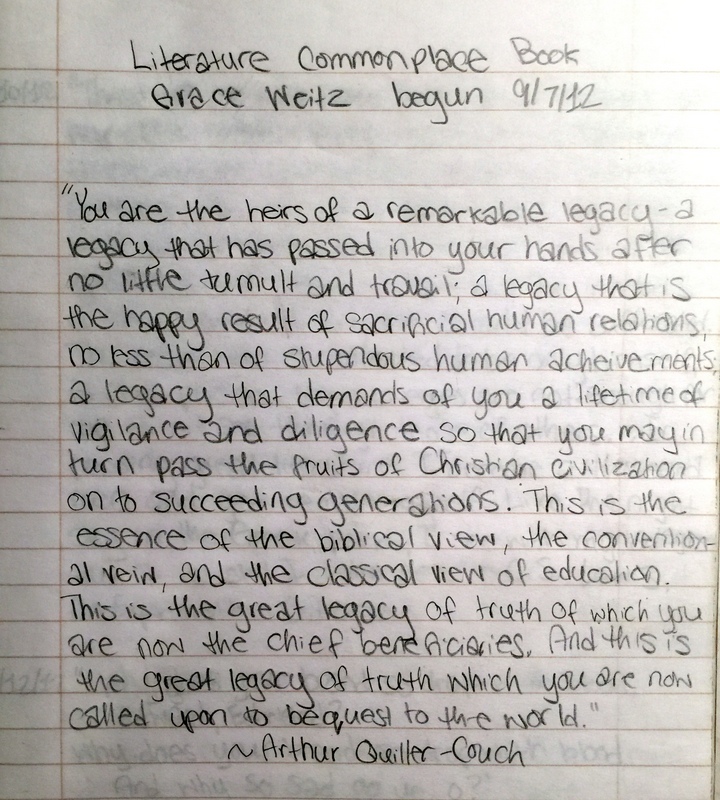
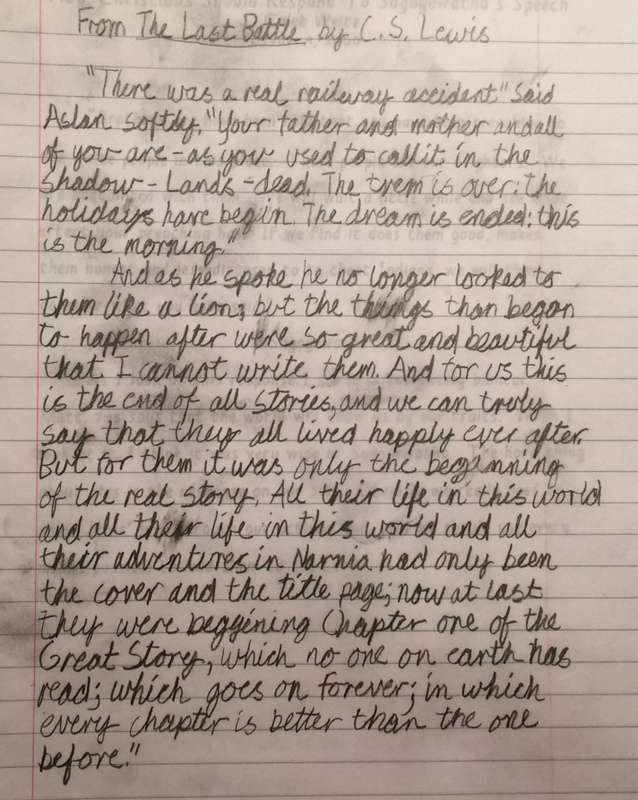
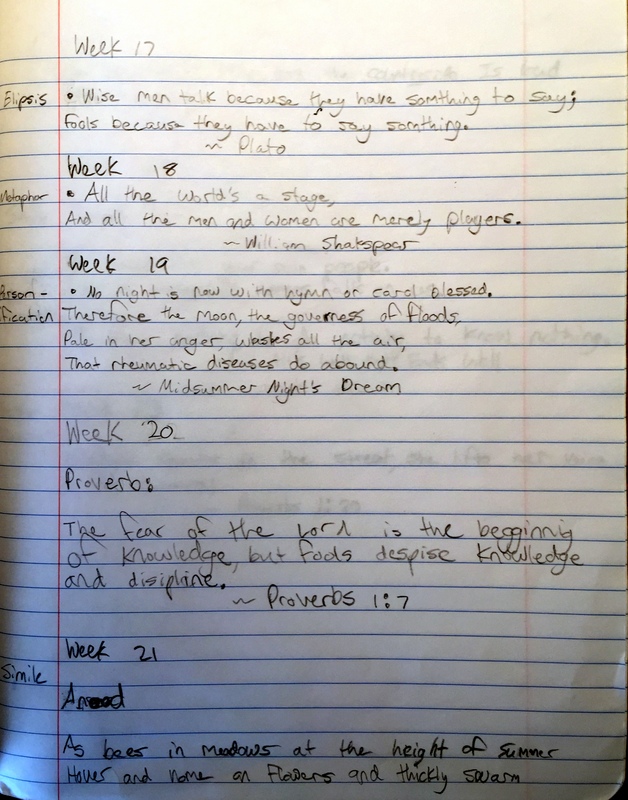
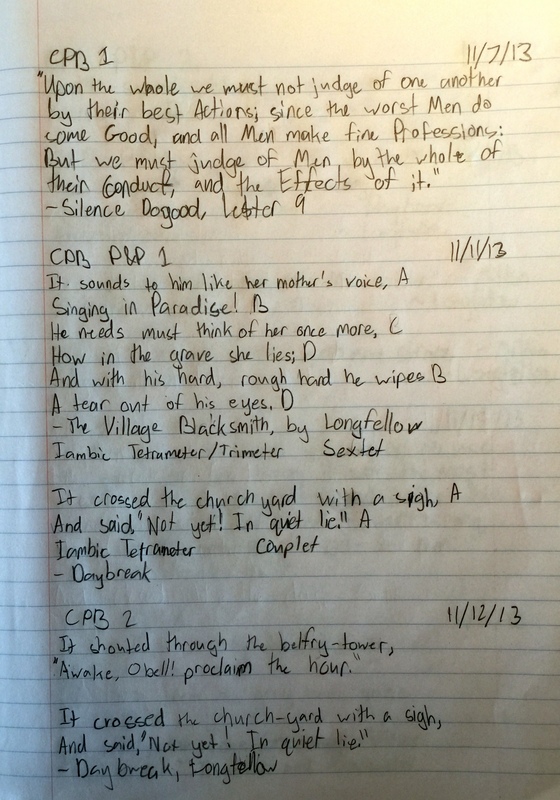
I started my younger children on a precursor to Commonplace books by photocopying the cover of their reading books. They glue the copied cover into their Commonplace books. Then I let them illustrate their favorite scenes from the book. I think I’ll take Mrs. Weitz idea and have them print a favorite passage into their Commonplace book next.
Thanks for the great ideas. This post certainly has my mind bubbling with ways to incorporate our grammar studies into our current reading selections.
Thanks for this post, Kathy. I enjoyed it. My own commonplacing practices are evolving–I just started within the last year–and I enjoy it and see the benefits already. I hope to start my rising 9th grade son on something like this next school year. Thanks for the samples from your kids’ books. :-)
How does an adult go about starting her own Classical education?
Thank you for this post. I never even knew there was such a thing as a commonplace book. Now, I’m eager to begin myself and introduce it into our homeschool. Thank you for taking the pressure off by not aiming us at perfection, but at patient persistence. That, I can do!
Just as a note, the link to “Cottage Press” at the beginning of this post is mislinked to “.com” The one at the end in the author info. is correct to “.net”. Don’t want anyone to miss out on the website.
Thank you, Cathy! I fixed that. :)